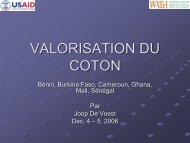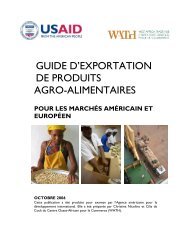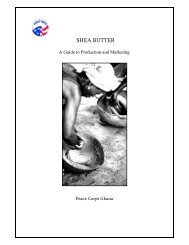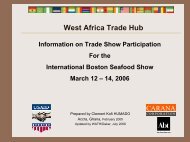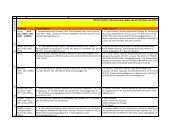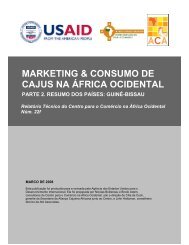A Brief Introduction to Textile Processing - AGOA Export Toolkit
A Brief Introduction to Textile Processing - AGOA Export Toolkit
A Brief Introduction to Textile Processing - AGOA Export Toolkit
You also want an ePaper? Increase the reach of your titles
YUMPU automatically turns print PDFs into web optimized ePapers that Google loves.
cot<strong>to</strong>n content. Designers wanting superior depth and richness of color, luster, but less concerned<br />
with washability, may select silk. Designers wanting ease of care may select nylon or polyester fibers.<br />
A table of characteristics of several commonly used fibers follows.<br />
Table 1. Typical characteristics of common textile fibers<br />
Fiber Strength Feel / Comfort Luster<br />
Cot<strong>to</strong>n Low, especially when wet Comfortable, especially in heat Average<br />
Wool Low, especially when wet Scratchy, uncomfortable in heat Low<br />
Silk High Smooth, comfortable in heat and cold High<br />
Polyester High Uncomfortable in heat Varies<br />
Nylon High Smooth, uncomfortable in heat High<br />
Fiber identification<br />
Each specific type of fiber can be easily and clearly identified by various visual, tactile, physical, and<br />
chemical tests. It should be noted, however, that sometimes more than one type of fiber may give the<br />
same results when tested using a certain method. Therefore, it may be necessary <strong>to</strong> conduct two or<br />
more different tests <strong>to</strong> determine the exact identification of the fiber.<br />
US law requires that all manufactured apparel sold in the United States carry a permanent label<br />
clearly stating the fiber content and care instructions for the garment. Apparel manufacturers should<br />
test incoming raw materials for their fiber content, or require that their suppliers provide proof of<br />
testing and results.<br />
A word of caution. Companies purchasing yarn or fabric described as, “silk,” “China silk,” “silky,”<br />
or “silken” should take care <strong>to</strong> have the fiber content tested and verified by an accredited third party<br />
lab. These terms are often used incorrectly and / or in purposely misleading ways <strong>to</strong> make buyers<br />
believe a particular yarn is silk when it is a different fiber. Similarly, companies buying yarns or<br />
fabrics labeled as “linen” should have the fiber content verified by testing at an independent lab as<br />
many less expensive fibers may be substituted for linen.<br />
Yarn<br />
Most fibers are <strong>to</strong>o short <strong>to</strong> be of any use in their original form. They must be formed in<strong>to</strong> yarn <strong>to</strong> be<br />
of real value in textile or apparel manufacturing. In order <strong>to</strong> form a yarn with sufficient strength and<br />
uniformity, the fibers must be straightened and aligned in a parallel orientation. Bundles of fiber must<br />
be twisted slightly, elongated, twisted again and elongated more, until the yarns form a thin, tight yarn<br />
suitable for weaving or knitting. It is the twist that holds the individual fibers <strong>to</strong>gether and gives<br />
strength <strong>to</strong> the yarn. More highly twisted yarns are generally stronger than less highly twisted yarns of<br />
the same fiber type and size. However, if the yarn is twisted <strong>to</strong>o much, it becomes less pliable,<br />
develops kinks, and becomes difficult <strong>to</strong> work with in a weaving loom or knitting frame, ultimately<br />
causing quality problems in the fabric.<br />
Yarn Manufacturing<br />
Although there may be some technology, terminology, or process differences between yarn<br />
manufacturing systems for cot<strong>to</strong>n, wool, linen, spun synthetics (e.g. spun polyester, acetate, etc.) or<br />
other fiber types, the general steps and workflow are similar. The general steps are:<br />
1. Cleaning (removing dirt and debris)<br />
2. Blending fibers<br />
Prepared by Margaret Bishop and Brent Smith for the West Africa Trade Hub 8/04 4



